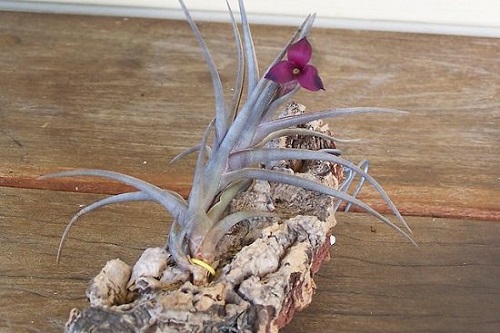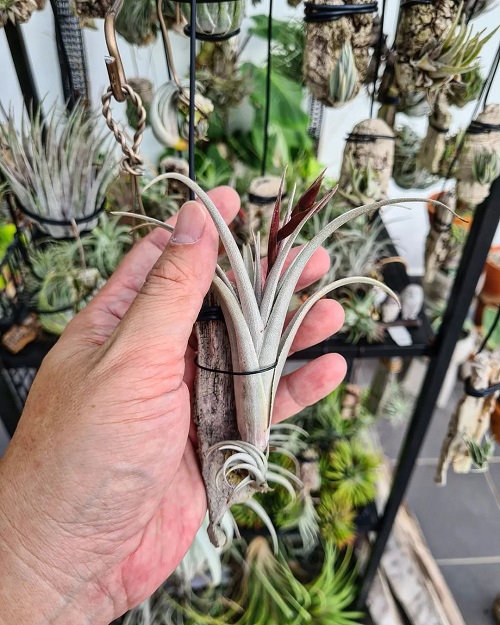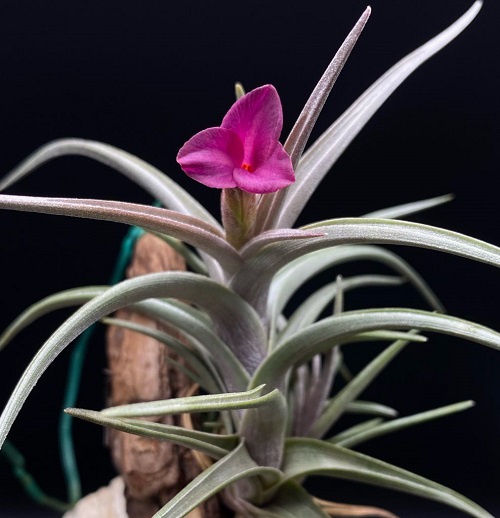Want to grow an eye-catching air plant? Go through our Tillandsia Zecheri Information and Growing guide for the same.
Tillandsia Zecheri, a captivating member of the bromeliad family, has captured the hearts of gardening enthusiasts with its distinct characteristics and relatively straightforward care requirements. This informative article delves into the essential aspects of Tillandsia Zecheri Information and Growing while giving its botanical features, preferred environmental conditions, and effective propagation methods.
- Botanical Name: Tillandsia zecheri
- Popular as- Zecheri Air Plant, Silvery Tillandsia
- Thrives in bright, indirect light
- Prefers temperature range between 60°F to 80°F (15.5°C to 26.6°C)
- Non-toxic nature for both pets and humans
Check Out The Best Jellyfish Air Plant Care Guide Here
What is Tillandsia Zecheri

Tillandsia Zecheri, with its mesmerizing visual appeal, emerges as a botanical wonder with distinct attributes that set it apart. The most captivating feature of Tillandsia Zecheri lies in its exquisite silvery-green hue, which gives it an ethereal quality. Its leaves, arranged in a mesmerizing rosette formation, create an elegant spherical shape that complements various interior design aesthetics. The plant’s size is generally compact, reaching dimensions of approximately 6 to 8 inches in diameter, making it an ideal choice for small spaces and decorative arrangements.
Find Where Do Air Plants Come From
Tillandsia Zecheri Propagation

Methods to propagate Tillandsia Zecheri
- Offset Division
- Seed Propagation
Easiest Method: Offsets/Pups
The offset division method remains the preferred choice among gardeners due to its reliability and practicality. Here’s a detailed breakdown of the steps involved:
- Begin by identifying offsets that have matured to at least one-third the size of the parent plant.
- Handle the offset with care, ensuring no damage to its delicate structure. Gently detach it from the parent plant using a clean, sharp tool.
- Allow the detached offset to air dry for one to two days. This phase is crucial to prevent excess moisture accumulation during the propagation process.
- Instead of relying on soil, air plants like Tillandsia Zecheri are often mounted on diverse surfaces. Opt for a unique substrate such as wood, a decorative rock, or any other creative option.
- Use waterproof glue, wire, or even natural materials like cotton thread to attach the offset to the chosen surface securely.
- Begin the propagation journey by lightly misting the offset and its chosen surface.
Find Out What Does a Healthy Air Plant Look Like Here
Tillandsia Zecheri Plant Flower
The Tillandsia Zecheri plant dazzles with its enchanting bloom, adding another layer of fascination to its allure. Its small flowers, often in shades of pink, lavender, or purple, emerge from the center of the plant’s rosette formation. The bloom carries a captivating fragrance, creating a sensory delight. Tillandsia Zecheri typically blooms during the warmer months, from late spring to early summer. The flowering duration varies, but a single bloom lasts several weeks on average.
Discover How Long Do Air Plants Live
How to Display Tillandsia Zecheri
1. Hanging Displays
Suspend Tillandsia Zecheri from the ceiling using elegant macramé hangers or decorative hooks. This allows the plant to “float” in the air, highlighting its ethereal beauty.
2. Terrariums
Incorporate Tillandsia Zecheri into glass terrariums alongside decorative stones, driftwood, or other air plants. The transparent enclosure allows one to appreciate its intricate features from all angles.
3. Mounted on Wood
Affix Tillandsia Zecheri to a piece of driftwood or a wooden plaque using floral wire or glue. This natural backdrop accentuates its organic charm while offering an artistic focal point.
4. Wall-mounted Arrangements
Attach Tillandsia Zecheri to a vertical surface using decorative mounts or adhesive hooks. Create a living art piece that adds a touch of nature to your walls.
5. Glass Orbs and Baubles
Insert Tillandsia Zecheri into transparent glass orbs, baubles, or hanging terrariums. These enclosed displays amplify the plant’s ethereal charm and allow you to observe its growth and blooms from all angles.
6. Tabletop Centerpieces
Place Tillandsia Zecheri on a decorative tray or dish filled with decorative pebbles, sand, or moss. Complement it with other air plants or succulents for an enchanting centerpiece.
Tillandsia Zecheri Plant Care
Position
Place your plant near a window with filtered sunlight or provide artificial light with a full-spectrum grow light. While Tillandsia Zecheri appreciates bright, indirect light, striking a balance is essential. Too much sunlight can burn leaves, while inadequate light hampers growth.
Airflow
Adequate airflow is a vital factor in the care of Tillandsia Zecheri. Air plants rely on air movement to prevent excess moisture buildup, which can lead to rot. When placing Tillandsia Zecheri, ensure it has enough space around it to encourage proper air circulation. This enhances its overall health and contributes to its resilience against potential fungal issues.
Water
Regular misting is crucial to maintain proper hydration. For larger plants, soak them in water for about 20-30 minutes every 1-2 weeks. After soaking, gently shake the plant to remove excess water and prevent rot.
Temperature
Protect Tillandsia Zecheri from extreme temperatures. This plant thrives in the moderate range of 60°F to 80°F (15.5°C to 26.6°C). It is also important to note that exposing it to temperatures below 50°F (10°C) can hamper its growth.
Pests and Diseases
Inspect your plant regularly for signs of pests like spider mites or mealybugs. Combat infestations with a solution of neem oil and water or insecticidal soap. Ensure proper air circulation to prevent fungal growth.
Check Out Our Article On Air Plant Care Here
How to FertilizeTillandsia Zecheri
Tillandsia Zecheri and other air plants absorb nutrients primarily from the air and water. Apply fertilizer made for air plants or bromeliads a few times annually. Alternatively, you can also use a common water-soluble indoor plant fertilizer but dilute it to one-fourth of the suggested amount. This diluted mixture can be added to your watering routine, whether you mist the plants or soak them in water.
Check Tillandsia Magnusiana Care and Growing
Frequently Asked Questions
1. Can Tillandsia Zecheri survive outdoors all year?
Tillandsia Zecheri can withstand outdoor conditions during warmer months, but it’s advised to bring them indoors when temperatures drop below 50°F (10°C) to prevent cold stress.
2. What should I do if my Tillandsia Zecheri’s leaves turn brown?
Browning leaves might indicate underwatering or excessive sunlight exposure. Adjust watering and light conditions accordingly, trimming any dead leaves carefully.
3. How often should I inspect my Tillandsia Zecheri for pests?
Regularly check your plant’s leaves, especially the undersides, for signs of pests like webs, discoloration, or tiny insects. Frequent inspection helps catch infestations early for prompt treatment.
Check Out Where Do Air Plants Come From Here


